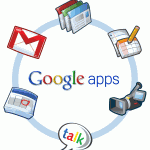Google Apps in Emergencies
Google provides a free suite of applications called Google Apps (paid licenses with support and additional features are also available with discounts for US-based non-profits). The applications include GMail, Google Docs, Google Calendar, Picasa and many others by Google and by third parties through the Google Apps Marketplace.
Google Apps is an interesting option for Humanitarian Aid organizations that quickly need to set up a field office in an emergency (as well as for HQ), despite the fact that web applications require an Internet connection (some work offline though, but more about that later and in future posts).
Take for example the requirement for a field office to use email and set up email accounts. I’ve often seen organizations use HQ-managed solutions or cumbersome local Outlook Exchange servers. Local Windows servers require skills that may not be to easy to find (or import) in an emergency and HQ-managed solutions do not offer enough control for field offices to quickly create a new email account or troubleshoot issues. Many aid workers have to resort to using personal email accounts which causes problems when those people leave as there is no easily searchable email history. Google Apps offers the familiar web interface of GMail and an easy way to centrally manage the email capability of a field office (share contacts, set up groups, add users, add aliases to accounts, built-in IM, store and search email, etc.). The only requirements are a domain name and a person with basic software skills. The ‘enterprise email’ capability and speed of setup are the key reasons to recommend Google Apps for humanitarian field offices that have a reasonable access to the Internet. The only real disadvantage over a local Microsoft Exchange Server (or similar solution) is that sending internal emails and receiving emails that are cc-ed to several people inside the same field office require more Internet traffic.
There is a wealth of additional benefits to using Google Apps in an emergency. For example Google Calendar facilitates the scheduling of meetings, sharing of each others schedules, and reserving shared resources (think for example about satellite phones, BGANs and cameras to take along on field trips). Google Docs is a great way to collaborate on the writing of documents such as proposals and can be combined with a third party application to automatically synchronize files with a local folder so they can be accessed and edited without an Internet connection (eg InSync). Picasa is an excellent tool for maintaining a photo database and supports features such a geo-tagging and basic editing. Moreover, uploaded photos can be instantly made available to fundraising colleagues in HQ. There are tons of other tools that could be (carefully) selected and made available to Google Apps users in the field office. They vary from advanced Project Management tools to Accounting. All tools are accessible with the same user account and can be centrally managed by the administrator.
Some of the Google Apps tools can be launched (and maintain their functionality) when the user is offline. This feature is not specific to Google Apps but Google is definitely on the forefront of introducing this state-of-the-art offline web application technology. This is an area I will write about much more in future posts as is it the specialty of Aid Web Solutions.
